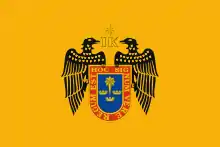National University of San Marcos
The National University of San Marcos (Spanish: Universidad Nacional Mayor de San Marcos, UNMSM) is a public research university in Lima, the capital of Peru. Also known as the University of Peru and the "Dean University of the Americas", it is the first officially established (privilege by Charles V, Holy Roman Emperor) and the oldest continuously operating university in the Americas.[6] Since its foundation, it was commonly referred as the "Royal and Pontifical University of the City of the Kings of Lima" until the Viceroyalty period and as of now, it is referred to as Universidad Nacional Mayor de San Marcos or La Decana de América.
Universidad Nacional Mayor de San Marcos | |
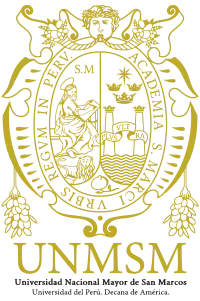 Latin: The Academy of St. Marcos in the City of Kings in Peru 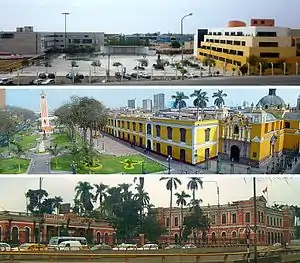 | |
| Latin: Academia S. Marci Vrbis Regvm in Perv | |
| Motto | Universidad del Perú, Decana de América |
|---|---|
Motto in English | University of Peru, Dean of the Americas |
| Type | Public |
| Established | May 12, 1551 |
| Founder | Charles V |
| Endowment | PEN S/. 400,732,439 (FY 2013)[1][2] |
| Rector | Dr. Orestes Cachay Boza |
Academic staff | 2,931 (2017) |
| Students | 37,032 (2017) |
| Undergraduates | 28,645 (2010)[3][4] |
| Postgraduates | 8,520 (2015)[5] |
| Location | , 12°03′30″S 77°05′00″W |
| Campus | Urban 70 hectares (170 acres) (main campus) |
| Colors | Gold Magenta White Steel blue |
| Mascot | Lion |
| Website | unmsm |
 | |
It is widely regarded as the most influential institution of higher-education in the country. It consistently ranks among the top two universities in the country.[7][8][9][10][11][12] Its main campus, the University City, is located in Lima. It was chartered on May 12, 1551, by a royal decree signed by Charles V, Holy Roman Emperor, which makes it the oldest officially established university in the Americas.[13][14] San Marcos has 66 academic-professional schools,[15] organized into 20 faculties, and 6 academic areas. All of the faculties offer undergraduate and graduate degrees. The student body consists of over 30,000 undergraduate and 4,000 graduate students from all the country, as well as some international students. The university has a number of public institutions under its government such as the San Marcos Cultural Center and the Museum of Natural History of Lima.
Notable alumni include the only Peruvian Nobel laureate so far, Mario Vargas Llosa, and twenty-one Peruvian presidents. San Marcos is also recognized for the quality of its curricular contents, a competitive admissions process, as well as for being a center of scientific research.[16] Several Peruvian and Latin American influential thinkers, researchers, scientists, politicians and writers have studied there, which underscores San Marcos' leading role as an educational institution in the history of Peru and the world.
History
Oldest university in the Americas
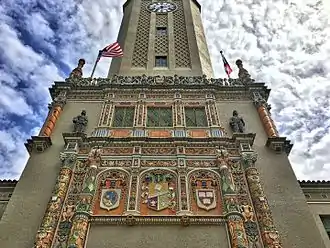
San Marcos is considered the oldest university in the Americas. It was officially established by a royal decree (signed by Charles V, Holy Roman Emperor) on May 12, 1551, and since then it has operated without interruption. Hence, it is locally known as the Dean of the Americas ("dean" in the sense of "oldest member"). San Marcos also claims that according to the Archivo General de Indias, a Spanish repository of documents on the former colonies in the sixteenth to eighteenth centuries, there were no official Spanish records of any other university or higher-education institution before 1551.[6]
Although the Autonomous University of Santo Domingo was founded in 1538, it was not officially recognized by Royal Decree until 1558, and, as many other universities in the Americas closed during independence wars and other political conflicts, it was closed due to the occupations of the Dominican Republic by Haiti and then the United States. The National University of Santo Domingo's founding Papal bull In Apostolatus culmine, was not officially recognized by the King of Spain at the time; hence making into an apocryphal document. The Peruvian institution also states that the document in question was discredited by Pope Paul III.[17][18]
Organization
Government
The university was originally headed by members of the clergy. During the Enlightenment, Bourbon reforms transformed it into a secular institution. Nowadays, the university is governed by:
- The University Council
- The University Assembly (composed of professors and students, with the latter holding a third of the seats)
- The Rector (president)
- Two Vice-Rectors:
- Academic Vice-Rector
- Vice-Rector of investigation
Academic areas
The original faculties at San Marcos were Theology, Arts (the old Scholastic term for what is now known as academic Philosophy) and Law; Jurisprudence, and Medicine were added later in the colonial period. The Faculty of Natural Sciences and the Faculty of Economics and Commerce were created in the mid-19th century. The Faculty of Science was subdivided by specialities in the 20th century. The Faculty of Theology was closed in 1935.
In the mid-1990s San Marcos' departments were grouped into four academic blocks. Nowadays, San Marcos' faculties are grouped into 6 academic areas.
| Academic area | Faculty | Department |
|---|---|---|
| A: HEALTH SCIENCES | 01. Faculty of Human Medicine |
01.1. Human Medicine |
| 01.2. Obstetrics | ||
| 01.3. Nursing | ||
| 01.4.1. Medical Technology: Clinical Laboratory and Pathological Anatomy 01.4.2. Medical Technology: Physical Therapy and Rehabilitation 01.4.3. Medical Technology: Radiology 01.4.4. Medical Technology: Occupational Therapy | ||
| 01.5. Nutrition | ||
04. Faculty of Pharmacy and Biochemistry |
04.1. Pharmacy and Biochemistry | |
| 04.2. Food Science | ||
| 04.3. Toxicology | ||
05. Faculty of Dentistry |
05.1. Odontology | |
08. Faculty of Veterinary Medicine |
08.1. Veterinary Medicine | |
18. Faculty of Psychology.png.webp) |
18.1. Psychology | |
| 18.2. Organizational Psychology and Human Management | ||
| B: BASIC SCIENCES | 07. Faculty of Chemistry and Chemical Engineering | 07.1. Chemistry |
| 10. Faculty of Biological Sciences | 10.1. Biological Sciences | |
| 10.2. Genetics and Biotechnology | ||
| 10.3. Microbiology and Parasitology | ||
| 13. Faculty of Physical Sciences | 13.1. Physics | |
| 14. Faculty of Mathematical Sciences | 14.1. Math | |
| 14.2. Statistics | ||
| 14.3. Operative investigation | ||
| 14.4. Scientific Computing | ||
| C: ENGINEERING | 07. Faculty of Chemistry and Chemical Engineering | 07.2. Chemical engineering |
| 07.3. Agroindustrial engineering | ||
| 13. Faculty of Physical Sciences | 13.2. Mechanical Engineering of Fluids | |
| 16. Faculty of Geological, Mining, Metallurgical and Geographical Engineering | 16.1. Geological Engineering | |
| 16.2. Geographical Engineering | ||
| 16.3. Mining Engineering | ||
| 16.4. Metallurgical Engineering | ||
| 16.5. Civil Engineering | ||
| 16.6. Environmental engineering | ||
17. Faculty of Industrial Engineering |
17.1. Industrial Engineering | |
| 17.2. Textile Engineering | ||
| 17.3. Occupational Health and Safety Engineering | ||
| 19. Faculty of Electronic and Electrical Engineering | 19.1. Electronic Engineering | |
| 19.2. Electric engineering | ||
| 19.3. Telecommunications Engineering | ||
| 20. Faculty of Systems Engineering and Informatics | 20.1. Systems engineer | |
| 20.2. Software Engineering | ||
| D: ECONOMIC AND MANAGEMENT SCIENCES | 09. Faculty of Administrative Sciences |
09.1. Business Administration |
| 09.2. Tourism Administration | ||
| 09.3. International Business management | ||
| 11. Faculty of Accounting Sciences | 11.1. Accounting | |
| 11.2. Tax management | ||
| 11.3. Business and Public Audit | ||
12. Faculty of Economic Sciences |
12.1. Economics | |
| 12.2. Public Economics | ||
| 12.3. International economics | ||
| E: HUMANITIES AND LEGAL AND SOCIAL SCIENCES | 03. Faculty of Letters and Human Sciences | 03.1. Literature |
| 03.2. Philosophy | ||
| 03.3. Linguistics | ||
| 03.4. Social Communication | ||
| 03.5. History of Art | ||
| 03.6. Librarianship and Information Sciences | ||
| 03.7. Dance | ||
| 03.8. Conservation and restoration | ||
| 06. Faculty of Education | 06.1.1. Initial education 06.1.2. Primary education 06.1.3.1. Secondary Education: English and Spanish 06.1.3.2. Secondary Education: Language and Literature 06.1.3.3. Secondary Education: History and Geography 06.1.3.4. Secondary Education: Philosophy, Tutoring and Social Sciences 06.1.3.5. Secondary Education: Mathematics and Physics 06.1.3.6. Secondary Education: Biology and Chemistry | |
| 06.2. Physical education | ||
| 02. Faculty of Law and Political Science | 02.1. Law | |
| 02.2. Politic Science | ||
| 15. Faculty of Social Sciences | 15.1. History | |
| 15.2. Sociology | ||
| 15.3. Anthropology | ||
| 15.4. Archeology | ||
| 15.5. Social Work | ||
| 15.6. Geography |
Research

Throughout its history, the National University of San Marcos has significantly contributed to the scientific development of Peru. Currently, the National University of San Marcos is one of the few Peruvian universities that conducts research – only 10 out of over 80 universities.[19] This is mostly due to the fact the national government has not properly financed research development in the last decades.[20]
Regarding development of research activities of San Marcos, halfway through the 20th century, the Peruvian government issued provisions to place emphasis and create areas of scientific and student-led research. As a result, throughout these years many museums and institutes have been created within San Marcos to promote research in different areas of human knowledge. During the last years of the decade of 1990 and the beginning of 2000, the university renewed its research system through the assignation of specific projects to diverse academic departments.[21]
Research centers and institutes
There are currently over 30 centers, units and institutes of research in San Marcos.[22][23][24] Each one of these centers or institutes are grouped according to the academic area where they develop their research, therefore they are categorized in the following general areas: health sciences, basic sciences, engineering, economy-business, and humanities.
According to their area of study, the research centers have specialized museums and laboratories where they develop and display their work. Each institute also has their own publications where they present reports and results of the work of their researchers.[22]
Ranking
The National University of San Marcos ranks as the first or second best university in Peru according to QS Ranking.[25][26][27] Together with the Pontifical Catholic University of Peru and Cayetano Heredia University are the three best universities of Peru. In the XIX and XX century, the San Marcos University has always obtained the first place in various national and international rankings,[28] but it also had several ups and downs. From the beginning of political activities, the presence of far-left politicians, the internal conflict in Peru[29] and now due to the lack of State investment, they were triggers for the San Marcos University to lose first place in rankings, in three occasions of a lot of years. Now in the third occasion, the Catholic University of Peru ranks as first in Peru since 2013.[30][31]In 2021, the Webometrics Ranking of World Universities of the Spanish National Research Council (CSIC) ranked the National University of San Marcos as the best university in the country, in its first ranking of the year.[32][33][34]
Notable alumni and academics
See also Category:National University of San Marcos alumni and Category:National University of San Marcos faculty
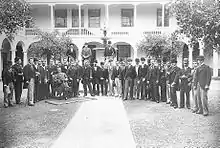
- Santiago Antúnez de Mayolo, engineer and scientist
- José María Arguedas, novelist and anthropologist
- Alberto Barton, physician and microbiologist
- Jorge Basadre, historian
- Luis Bedoya Reyes, attorney, congressman, Mayor of Lima and founder of the Christian People's Party
- G. E. Berrios, professor of psychiatry at the University of Cambridge
- Bertha Bouroncle, physician
- Alfredo Bryce Echenique, novelist
- Carlos Bustamante, biophysicist
- Daniel Alcides Carrión, medical student and pioneer in medical research
- Ramiro Castro de la Mata Caamaño, scientist
- Carlos Manuel Chavez, heart surgeon
- José Santos Chocano, poet
- Antonio Cornejo-Polar, literary critic
- Luis A. Eguiguren, educator, magistrate, historian and Peruvian politician
- Godofredo García, mathematician and engineer
- Víctor Raúl Haya de la Torre, revolutionary thinker, founder of the American Popular Revolutionary Alliance (APRA)
- Cayetano Heredia, physician
- Elmer Huerta, physician and health communicator
- Mariano Iberico Rodríguez, philosopher
- Andy Martínez, athlete and national record
- Francisco Miró Quesada Cantuarias, philosopher and logician
- Carlos Monge Medrano, physician
- Bernardo O'Higgins, military officer and first President of Chile
- Valentín Paniagua Corazao, former President of Peru
- Hugo Pesce, physician and leprosy specialist
- Laura Esther Rodriguez Dulanto, first female physician in Peru
- Luis Alberto Sánchez, writer and statesman
- Manuel Scorza, novelist
- Ruth Shady, archaeologist and anthropologist
- Julio C. Tello, physician, archaeologist, and anthropologist
- Hipólito Unanue, physician
- Abraham Valdelomar, poet and short-story writer
- Mario Vargas Llosa, novelist, Nobel Prize in Literature (2010)
- Federico Villarreal, scientist and mathematician
- Augusto Weberbauer, German naturalist
- Pedro Zulen, philosopher and librarian
- María Luisa Aguilar, Peruvian astronomer
Gallery
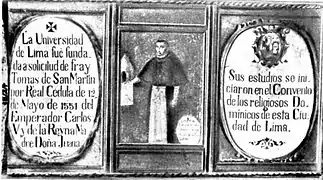 Oil painting commemorating the foundation of the University of Lima (later named San Marcos), officially the first university in Peru and the Americas, and his manager Friar Tomas of San Martin
Oil painting commemorating the foundation of the University of Lima (later named San Marcos), officially the first university in Peru and the Americas, and his manager Friar Tomas of San Martin The historic chapter house at the Basilica and Convent of Santo Domingo, where the University of San Marcos began its operations
The historic chapter house at the Basilica and Convent of Santo Domingo, where the University of San Marcos began its operations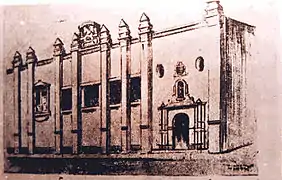 Drawing showing the old facade of the premises where the University of San Marcos functioned throughout the Peruvian viceroyalty. Later this place would be transferred to the nascent Congress of Peru.
Drawing showing the old facade of the premises where the University of San Marcos functioned throughout the Peruvian viceroyalty. Later this place would be transferred to the nascent Congress of Peru.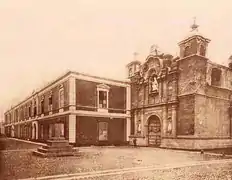 Local University of San Marcos in 1920, the famous "Casona de San Marcos is currently the Centro Cultural de San Marcos
Local University of San Marcos in 1920, the famous "Casona de San Marcos is currently the Centro Cultural de San Marcos Welcome Mural Universidad Nacional Mayor de San Marcos, as he mentioned the official date of its foundation: May 12 of 1551
Welcome Mural Universidad Nacional Mayor de San Marcos, as he mentioned the official date of its foundation: May 12 of 1551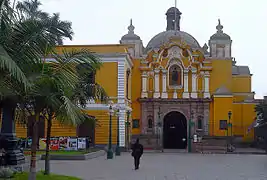 La Casona de San Marcos, used as the cultural center
La Casona de San Marcos, used as the cultural center Jorge Basadre building, used for administrative functions
Jorge Basadre building, used for administrative functions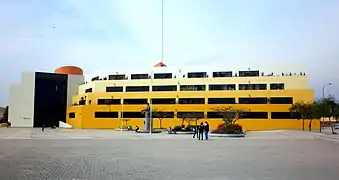 Main library
Main library San Marcos University Press
San Marcos University Press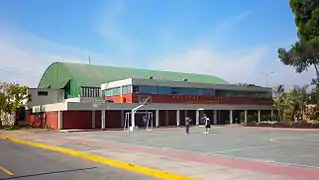 San Marcos University Gym
San Marcos University Gym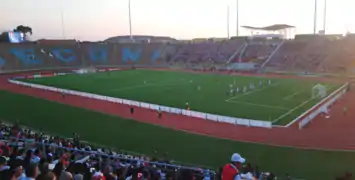 San Marcos University Stadium
San Marcos University Stadium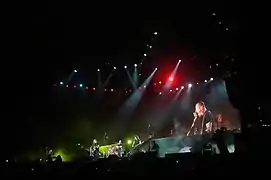 Metallica concert at University of San Marcos
Metallica concert at University of San Marcos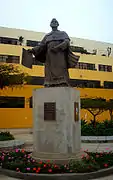 Monument of Fray Tomas de San Martín
Monument of Fray Tomas de San Martín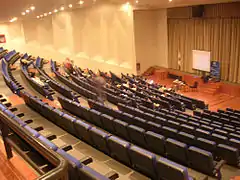 Main auditorium
Main auditorium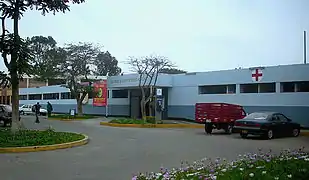 San Marcos University Clinic
San Marcos University Clinic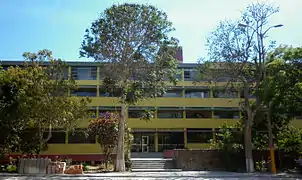 Institute of Tropical Medicine
Institute of Tropical Medicine Museum of Natural History
Museum of Natural History
See also
References
- Cayo Códova, Percy (2004). Enciclopedia Temática del Perú. TOMO III: República (in Spanish). Lima, Perú: Orbis Ventures, El Comercio. ISBN 9972-752-03-8.
- Del Busto Duthurburu, José Antonio (2004). Enciclopedia Temática del Perú. TOMO II: Conquista y Virreinato (in Spanish). Lima, Perú: Orbis Ventures, El Comercio. ISBN 9972-752-02-X.
- De León Pinelo, Antonio (1631). Por la real Universidad y escuelas generales de S. Marcos de la ciudad de Lima, en las provincias del Perú (in Spanish). Madrid, España.
- Eguiguren Escudero, Luis Antonio (1959) [1949, 1951]. Diccionario histórico-cronológico de la Real y Pontifica Universidad de San Marcos y sus colegios (in Spanish). Lima, Perú: Fondo Editorial de la UNMSM.
- Eguiguren Escudero, Luis Antonio (1951). Historia de la Universidad. La universidad en el Siglo XVI (in Spanish). Lima, Perú: Fondo Editorial de la UNMSM.
- García Cáceres, Uriel (2004). Enciclopedia Temática del Perú. TOMO XII: Salud (in Spanish). Lima, Perú: Orbis Ventures, El Comercio. ISBN 9972-752-12-7.
- García Zárate, Óscar Augusto [compilador] (2003). Hacia una nueva universidad en el Perú (in Spanish). Lima, Perú: Fondo Editorial de la UNMSM.
- González Vigil, Ricardo (2004). Enciclopedia Temática del Perú. TOMO XIV: Literatura (in Spanish). Lima, Perú: Orbis Ventures, El Comercio. ISBN 9972-752-14-3.
- Higgins, James (2005). Lima: A cultural history. Nueva York, EEUU: Oxford University Press. ISBN 0-19-517890-4.
- Maticorena Estrada, Miguel (2000). San Marcos de Lima, Universidad Decana de América, una argumentación histórica-jurídica y el derecho indiano (in Spanish). Lima, Perú: Fondo Editorial de la UNMSM.
- Porras Barrenechea, Raúl (2010). San Marcos y la cultura peruana: Mito, tradición e historia del Perú (in Spanish). Lima, Perú: Fondo Editorial de la UNMSM.
- Sánchez Sánchez, Luis Alberto (1961). La universidad no es una isla... Un estudio, un plan, y tres discursos (in Spanish). Lima, Perú: Ediciones Perú.
- Universidad Nacional Mayor de San Marcos (2007). Catálogo Universitario y Prospecto de Admisión 2008-II (in Spanish). Lima, Perú: Centro de Producción e Imprenta de la UNMSM.
- Universidad Nacional Mayor de San Marcos (2010). Catálogo Universitario y Prospecto de Admisión 2011-I (in Spanish). Lima, Perú: Centro de Producción e Imprenta de la UNMSM.
- Valcárcel Esparza, Carlos Daniel (1981). Historia de la Universidad de San Marcos (1551–1980) (in Spanish). Caracas: Academia Nacional de la Historia.
- Valcárcel Esparza, Carlos Daniel (2001). San Marcos, Universidad Decana de América (in Spanish). Lima, Perú: Fondo Editorial de la UNMSM. ISBN 9972-46-140-8.
- López Soria, José Ignacio; et al. (2004). Enciclopedia Temática del Perú. TOMO XI: Ciencia y Tecnología (in Spanish). Lima, Perú: Orbis Ventures, El Comercio. ISBN 9972-752-11-9.
- Peña Rodríguez, Víctor Antonio; et al. (2002). La Producción científica en San Marcos (1995-2001) (in Spanish). Lima, Perú: Fondo Editorial de la UNMSM.
- Summerfield, Carol J.; et al. (1998). International Dictionary of University Histories. Chicago, Illinois, EEUU: Fitzroy Dearborn Publishers. ISBN 1-884964-23-0.
Notes
- Universidad Coherente. "Presupuesto 2000–2013 en millones de nuevos soles" (in Spanish). Archived from the original on July 21, 2013. Retrieved May 30, 2013.
- Portal de Transparencia Universitaria (UNMSM). "Información presupuestal" (in Spanish). Archived from the original on April 19, 2012. Retrieved February 10, 2011.
- INEI-ANR. "II Censo Nacional Universitario 2010" (PDF) (in Spanish). Archived from the original (PDF) on August 13, 2012. Retrieved February 4, 2011.
- Revista "San Marcos al día" (UNMSM). "San Marcos al día (n° 212): San Marcos en la sociedad del conocimiento" (PDF) (in Spanish). Retrieved August 30, 2010.
- Revista "San Marcos al día" (UNMSM). "San Marcos al día (n° 308): Excelencia académica y moderna infraestructura" (PDF) (in Spanish). Retrieved October 17, 2015.
- "Fundación de la Universidad de Santo Domingo" (in Spanish). Retrieved March 25, 2019.
- "Ranking universitario en el Perú" (PDF). Asamblea Nacional de Rectores (ANR) and UNESCO. Archived from the original (PDF) on November 4, 2013. Retrieved February 11, 2013.
- "QS Latin American University Rankings 2013". Retrieved July 24, 2013.
- "University Ranking by Academic Performance (2013): Top Perú". URAP Center. Retrieved July 24, 2013.
- "Ranking Web of Universities: Peru". Webometrics. Retrieved July 4, 2013.
- "SIR World Report 2013" (PDF). SCImago. Archived from the original (PDF) on August 16, 2013. Retrieved July 24, 2013.
- "UNMSM recibe acreditación internacional Archived 2011-04-16 at the Wayback Machine". Peru21. Accessed April 26, 2011. (in Spanish)
- "Foundation of the University of Lima". San Marcos National University. Accessed August 22, 2009. (in Spanish)
- http://www.unmsm.edu.pe/home/inicio/historia
- "Escuelas Profesionales – Oficina Central de Admisión". www.admision.unmsm.edu.pe. Retrieved October 24, 2019.
- Ranking and research supported by: UNESCO and Asamblea Nacional de Rectores, 2007
- http://sisbib.unmsm.edu.pe/bibvirtual/libros/historia/San_marcos/Fund_Uni_Sto_Domin.htm
- http://sisbib.unmsm.edu.pe/bibvirtual/libros/historia/San_marcos/Fund_Uni_Lima.htm
- "Sistema Nacional de Ciencia, Tecnología e Innovación Tecnológica (SINACYT)". July 27, 2010. Archived from the original on July 27, 2010. Retrieved October 24, 2019.
- Enciclopedia temática del Perú (in Spanish). El Comerio. 2004. ISBN 9789972752117.
- "La producción científica en San Marcos (1995–2001)". sisbib.unmsm.edu.pe. Retrieved October 24, 2019.
- "Institutos de Investigación de Universidades del Perú : Biblioteca Virtual en Ciencia y Tecnología". December 13, 2011. Archived from the original on December 13, 2011. Retrieved October 24, 2019.
- "Unidades Desconcentradas – Vicerrectorado de Investigación y Posgrado | UNMSM" (in Spanish). Retrieved October 24, 2019.
- "Unidades e Institutos de Investigación". December 21, 2012. Archived from the original on December 21, 2012. Retrieved October 24, 2019.
- "Main National University of San Marcos of Lima | university, Lima, Peru". Encyclopedia Britannica. Retrieved December 10, 2020.
- "Perú | Ranking Web de Universidades: Webometrics clasifica 30000 instituciones". www.webometrics.info. Retrieved December 10, 2020.
- "Las Mejores Universidades del Perú – Ránking 2010 – AméricaEconomía". rankings.americaeconomia.com. Retrieved December 10, 2020.
- Estrada-Cuzcano, Alonso; alfaro-Mendives, Karen lizeth (January 2016). "Presencia de la Universidad Nacional Mayor de San Marcos en la Bibliotecología Peruana: Estudio historiográfico". Letras (Lima). 87 (125): 105–122. ISSN 2071-5072.
- "Sendero en San Marcos | EL MONTONERO". EL MONTONERO | Primer Portal de opinión del país (in Spanish). Retrieved December 10, 2020.
- "LAS MEJORES UNIVERSIDADES DE PERÚ – Ranking 2012". rankings.americaeconomia.com. Retrieved December 10, 2020.
- "Ranking QS Mundial 2021: PUCP alcanza su mejor posición histórica entre las universidades latinoamericanas". Zona Escolar (in Spanish). June 11, 2020. Retrieved December 10, 2020.
- Cruz, Yohel (January 29, 2021). "Ranking de Webometrics ubica a San Marcos como la mejor universidad del Perú". RPP (in Spanish). Retrieved February 1, 2021.
- "Universidad | Ranking Web de Universidades: Webometrics clasifica 30000 instituciones". www.webometrics.info. Retrieved February 1, 2021.
- "UNMSM: Universidad San Marcos figura entre las 1,000 mejores del mundo, según QS World University Rankings". EDUCACIONENRED.PE (in Spanish). Retrieved February 1, 2021.
External links
| Wikimedia Commons has media related to: |
- (in Spanish) Universidad Nacional Mayor de San Marcos website
- (in Spanish) Faculty of Medicine website
